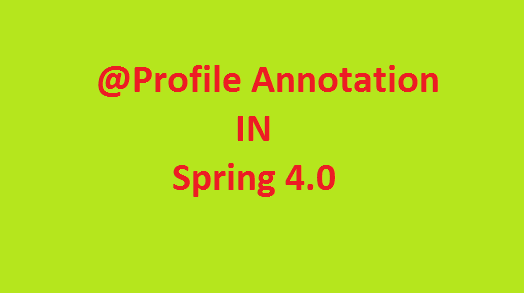This tutorial explain how to enable profiles in your spring application for different environments. Also this tutorial explains the new improvements in the Spring 4.0 release and how it is different from the older releases.
If you are working for a real time projects, it is often basic requirement to have the different environments like development, testing and production. In this scenario, the underlying resources (ie, database, file system, etc) for each environment would be different. The challenges arises when you want to move your source code to different environments. You would have to adjust the configurations to point to new environment details like Database, etc. The solution for the above problem is to create different profiles for each environment and enable them when you move to another environment.
List of Spring Tutorials : Spring Tutorial
@Profile annotation is introduced as part of the Spring Framework 3.1 release. @Profile annotation helps developers to create multiple configurations details for different environments. Prior to Spring 4, only bean level annotation is supported by @Profile. With Spring 4, this can be used in the method level. That gives more control and eliminate the need for creating multiple configuration files. This tutorial provide simple example for @Profile annotation.
Spring official document defines @Profile as:
Spring Profiles provide a way to segregate parts of your application configuration and make it only available in certain environments.
I have written a very simple example to demonstrate the power of @Profile feature in Spring 4. This example declares data source for dev and prod. By using the @Profile annotation, a suitable data source will be invoked by the test class.

@Profile Annotation
The syntax for this annotation is @Profile(“dev”). If a bean or method marked with annotation will be associated with that particular profile name. This example uses the method type annotation (Spring 4 improvements). Where as you also do it in the class level.
@ActiveProfiles Annotation
How do we tell the container that which profile is active now to pick up the right configurations. We have to use @ActiveProfiles to tell the currently active profile. This can be done through XML, JavaConfig, Annotations and Programatically.
Annotation Configuration
@ActiveProfiles(profiles = "dev")
public class DevConfigTest {
//code here
}
Web.xml Configuration
<context-param> <param-name>spring.profiles.active</param-name> <param-value>DOUBLEUPMINT</param-value> </context-param>
Programatic Configuration
AnnotationConfigApplicationContext context = new AnnotationConfigApplicationContext();
//Enable a "live" profile
context.getEnvironment().setActiveProfiles("live");
@Profile Annotation Example
Here is the example application using @Profile annotation.
Student.java
package javabeat.net.spring.core;
public class Student {
private String id;
private String name;
private String grade;
public Student(String id, String name, String grade){
this.id = id;
this.name = name;
this.grade = grade;
}
public String getId() {
return id;
}
public void setId(String id) {
this.id = id;
}
public String getName() {
return name;
}
public void setName(String name) {
this.name = name;
}
public String getGrade() {
return grade;
}
public void setGrade(String grade) {
this.grade = grade;
}
}
DevEnvConfig.java
package javabeat.net.spring.core;
import org.springframework.context.annotation.Bean;
import org.springframework.context.annotation.Configuration;
import org.springframework.context.annotation.Profile;
@Configuration
@Profile("dev")
public class DevEnvConfig {
@Bean
public Student user(){
return new Student("001", "Dev Student 1","Grade 1");
}
}
ProdEnvConfig.java
package javabeat.net.spring.core;
import org.springframework.context.annotation.Bean;
import org.springframework.context.annotation.Configuration;
import org.springframework.context.annotation.Profile;
@Configuration
@Profile("prod")
public class ProdEnvConfig {
@Bean
public Student user(){
return new Student("002", "Prod Student 1","Grade 2");
}
}
ProductionDataSourceConfig.java
package javabeat.net.spring.core;
import javax.sql.DataSource;
import org.springframework.context.annotation.Bean;
import org.springframework.context.annotation.Configuration;
import org.springframework.context.annotation.Profile;
@Configuration
@Profile("prod")
public class ProductionDataSourceConfig {
@Bean
public DataSource dataSource(){
//Do connection related task
return null;
}
}
SpringProfileTest.java
package javabeat.net.spring.core;
import org.springframework.context.annotation.AnnotationConfigApplicationContext;
public class SpringProfileTest {
public static void main(String[] args) {
AnnotationConfigApplicationContext ctx = new AnnotationConfigApplicationContext();
ctx.getEnvironment().setActiveProfiles("prod");
ctx.scan("javabeat.net.spring.core");
ctx.refresh();
Student student = ctx.getBean(Student.class);
System.out.println("\nStudent Id:" + student.getId() + ", \nStudent Name:" + student.getName()
+ ", \nStudent Grade : " + student.getGrade());
}
}
Summary
This tutorial demonstrated how to use @Profile annotation in your project. It is a simple example and I hope this helps you to understand the concepts. If you have any questions, please write it in the comments section.

 Spring Boot : Running Spring MVC Application
Spring Boot : Running Spring MVC Application